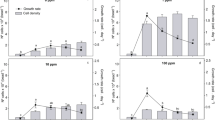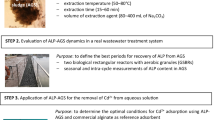Abstract
Secondary treatment of municipal wastewater affects the mechanical stability of polymer Ca-alginate beads containing the microalgae Chlorella vulgaris that are jointly immobilized with Azospirillum brasilense as treating agents whose presence do not affect bead stability. Nine strains of potential alginate-degrading bacteria were isolated from wastewater and identified, based on their nearly complete 16S rDNA sequence. Still, their population was relatively low. Attempts to enhance the strength of the beads, using different concentrations of alginate and CaCl2 or addition of either of three polymers (polyvinylpyrrolidone, polyvinyl alcohol, carboxymethylcellulose), CaCO3, or SrCl2, failed. Beads lost their mechanical strength after 24 h of incubation but not the integrity of their shape for at least 96 h, a fact that sustained successful tertiary wastewater treatment for 48 h. In small bioreactors, removal of phosphorus was low under sterile conditions but high in unsterile wastewater. Alginate beads did not absorb PO4 −3 in sterile wastewater, but in natural wastewater, they contained PO4 −3. Consequently, PO4 −3 content declined in the wastewater. A supplement of 10 % beads (w/v) was significantly more efficient in removing nutrients than 4 %, especially in a jointly immobilized treatment where >90 % of PO4 −3 and >50 % ammonium were removed. Tertiary wastewater treatment in 25-L triangular, airlift, autotrophic bioreactors showed, as in small bioreactors, very similar nutrient removal patterns, decline in bead strength phenomena, and increase in total bacteria during the wastewater treatment only in the presence of the immobilized treatment agents. This study demonstrates that partial biological degradation of alginate beads occurred during tertiary wastewater treatment, but the beads survive long enough to permit efficient nutrient removal.






Similar content being viewed by others
References
Bashan Y (1986) Alginate beads as synthetic inoculant carriers for the slow release of bacteria that affect plant growth. Appl Environ Microbiol 51:1089–1098
Bashan Y, de-Bashan LE (2005) Bacteria/plant growth-promotion. In: Hillel D (ed) Encyclopedia of soils in the environment, vol 1. Elsevier, Oxford, pp 103–115
Bashan Y, de-Bashan LE (2010) How the plant growth-promoting bacterium Azospirillum promotes plant growth-a critical assessment. Adv Agron 108:77–136
Bashan Y, Holguin G, Lifshitz R (1993) Isolation and characterization of plant growth-promoting rhizobacteria. In: Glick BR, Thompson JE (eds) Methods in plant molecular biology and biotechnology. CRC Press, Boca Raton, pp 331–345
Bashan Y, Hernandez JP, Leyva LA, Bacilio M (2002) Alginate microbeads as inoculant carrier for plant growth-promoting bacteria. Biol Fertil Soils 35:359–368
Bashan Y, Holguin G, de-Bashan LE (2004) Azospirillum-plant relationships: physiological, molecular, agricultural, and environmental advances (1997–2003). Can J Microbiol 50:521–577
Bashan Y, Trejo A, de-Bashan LE (2011) Development of two culture media for mass cultivation of Azospirillum spp. and for production of inoculants to enhance plant growth. Biol Fertil Soils 47:963–969
Bitton G (2010) Wastewater microbiology. Wiley series in ecological and applied microbiology, 4th edn. John Wiley & Sons, Hoboken
Bond PL, Erhart R, Wagner M, Keller J, Blackall LL (1999) Identification of some of the major groups of bacteria in efficient and nonefficient biological phosphorus removal activated sludge systems. Appl Environ Microbiol 65:4077–4084
Chen K-C, Lin YF (1994) Immobilization of microorganisms with phosphorylated polyvinyl alcohol (PVA) gel. Enzyme Microb Technol 16:79–83
Chrzanowski TH, Crotty RD, Hubbard JG, Welch RP (1984) Applicability of the fluorescein diacetate method of detecting active bacteria in freshwater. Microb Ecol 10:179–185
Covarrubias SA, de-Bashan LE, Moreno M, Bashan Y (2012) Alginate beads provide a beneficial physical barrier against native microorganisms in wastewater treated with immobilized bacteria and microalgae. Appl Microbiol Biotechnol 93:2669–2680
Dainty AL, Goulding KH, Robinson PK, Simpkins H, Trevan MD (1986) Stability of alginate-immobilized algal cells. Biotechnol Bioeng 28:210–216
de la Noüe J, Proulx D (1988) Biological tertiary treatment of urban wastewaters with chitosan-immobilized Phormidium. Appl Microbiol Biotechnol 29:292–297
de-Bashan LE, Bashan Y (2004) Recent advances in removing phosphorus from wastewater and its future use as fertilizer (1997–2003). Water Res 38:4222–4246
de-Bashan LE, Bashan Y (2010) Immobilized microalgae for removing pollutants: review of practical aspects. Bioresource Technol 101:1611–1627
de-Bashan LE, Bashan Y, Moreno M, Lebsky VK, Bustillos JJ (2002a) Increased pigment and lipid content, lipid variety, and cell and population size of the microalgae Chlorella spp. when co-immobilized in alginate beads with the microalgae-growth-promoting bacterium Azospirillum brasilense. Can J Microbiol 48:514–521
de-Bashan LE, Moreno M, Hernandez JP, Bashan Y (2002b) Removal of ammonium and phosphorus ions from synthetic wastewater by the microalgae Chlorella vulgaris coimmobilized in alginate beads with the microalgae growth-promoting bacterium Azospirillum brasilense. Water Res 36:2941–2948
de-Bashan LE, Hernandez JP, Morey T, Bashan Y (2004) Microalgae growth-promoting bacteria as “helpers” for microalgae: a novel approach for removing ammonium and phosphorus from municipal wastewater. Water Res 38:466–474
de-Bashan LE, Rothballer M, Schmid M, Hartmann A, Bashan Y (2011) Cell–cell interaction in the eukaryote-prokaryote model using the microalgae Chlorella vulgaris and the bacterium Azospirillum brasilense immobilized in polymer beads. J Phycol 47:1350–1359
Doria-Serrano MC, Ruiz-Treviño FA, Rios-Arciga C, Hernández-Esparza M, Santiago P (2001) Physical characteristics of poly(vinyl alcohol) and calcium alginate hydrogels for the immobilization of activated sludge. Biomacromolecules 2:568–574
Draget KI, Moe ST, Skjåk-Bræk G, Smidsrød O (2006) Alginate. In: Stephen AM, Phillips GO, Williams PA (eds) Food polysaccharides and their application, 2nd edn. CRC Press, Boca Raton
Eaton AD, Clesceri LS, Rice EW, Greenberg AE (eds) (2005) Standard methods for the examination of water and wastewater, 21st edn. American Public Health Association, American Waterworks Association, Water Environmental Federation. Port City Press, Pikeville
Gaserød O, Sannes A, Skjåk-Bræk G (1999) Microcapsules of alginate–chitosan. II. A study of capsule stability and permeability. Biomaterials 20:773–783
Gonzalez LE, Bashan Y (2000) Growth promotion of the microalga Chlorella vulgaris when coimmobilized and cocultured in alginate beads with the plant-growth-promoting bacterium Azospirillum brasilense. Appl Environ Microbiol 66:1527–1531
Gonzalez LE, Cañizares RO, Baena S (1997) Efficiency of ammonia and phosphorus removal from a Colombian agroindustrial wastewater by the microalgae Chlorella vulgaris and Scenedesmus dimorphus. Bioresourse Technol 60:259–262
Henze M, Harremoes P, Jansen JC, Arvin E (2002) Wastewater treatment: biological and chemical processes. Springer, Heidelberg
Hernandez JP, de-Bashan LE, Bashan Y (2006) Starvation enhances phosphorus removal from wastewater by the microalga Chlorella spp. co-immobilized with Azospirillum brasilense. Enzyme Microb Technol 38:190–198
Hernández-López J, Vargas-Albores F (2003) A microplate technique to quantify nutrients (NO2 –, NO3 –, NH4 + and PO4 –3) in seawater. Aquac Res 34:1201–1204
Hrenovic J, Kovacevic D, Ivankovic T, Tibljas D (2011) Selective immobilization of Acinetobacter junii on the natural zeolitized tuff in municipal wastewater. Colloid Surf B 88:208–214
Ilangovan K, Cañizares-Villanueva RO, González-Moreno S, Voltolina D (1998) Effect of cadmium and zinc on respiration and photosynthesis in suspended and immobilized cultures of Chlorella vulgaris and Scenedesmus acutus. Bull Environ Contam Toxicol 60:936–943
Joo DS, Cho MG, Lee JS, Park JH, Kwak JK, Han YH, Bucholz R (2001) New strategy for the cultivation of microalgae using microencapsulation. J Microencapsul 18:567–576
Kierstan MPJ, Coughlan MP (1985) Immobilisation of cells and enzymes by gel entrapment. In: Woodward J (ed) Immobilised cells and enzymes: a practical approach. IRL Press, Oxford, pp 39–48
Lebeau T, Robert JM (2006) Biotechnology of immobilized micro algae: a culture technique for the future? In: Rao S (ed) Algal cultures, analogues of blooms and applications. Science Publishers, Enfield, pp 801–837
Lebsky VK, Gonzalez-Bashan LE, Bashan Y (2001) Ultrastructure of coimmobilization of the microalga Chlorella vulgaris with the plant growth-promoting bacterium Azospirillum brasilense and with its natural associative bacterium Phyllobacterium myrsinacearum in alginate beads. Can J Microbiol 47:1–8
Martinsen A, Skjåk-Bræk G, Smidsrød O (1989) Alginate as immobilization material. I. Correlation between chemical and physical properties of alginate gel beads. Biotechnol Bioeng 33:79–89
Mata TM, Martins AA, Caetano NS (2010) Microalgae for biodiesel production and other applications: a review. Renew Sust Energ Rev 14:217–232
McHugh DJ (1987) Production and utilization of products from commercial seaweeds. FAO Fisheries Technical Paper No 288, Rome
Mino T, Van Loosdrecht MCM, Heijnen JJ (1998) Microbiology and biochemistry of the enhanced biological phosphate removal process. Water Res 32:3193–3207
Moreira SM, Moreira-Santos M, Guilhermino L, Ribeiro R (2006) Immobilization of the marine microalga Phaeodactylum tricornutum in alginate for in situ experiments: bead stability and suitability. Enzyme Microb Technol 38:135–141
Nussinovitch A (2010) Polymer macro- and micro-gel beads: fundamentals and applications. Springer, Berlin, 303 pp
Olsen SR, Sommers LE (1982) Phosphorus. In: Page AL (ed) Methods of soil analysis. Part 2. Chemical and microbiological properties, 2nd edn. American Society of Agronomy and Soil Science Society of America, Madison, pp 406–407
Onuki M, Satoh H, Mino T (2002) Analysis of microbial community that performs enhanced biological phosphorus removal in activated sludge fed with acetate. Water Sci Technol 46:145–153
Oswald WJ (1992) Microalgae and wastewater treatment. In: Borowitzka MA, Borowitzka LJ (eds) Microalgal biotechnology. Cambridge University Press, Cambridge, pp 305–328
Perez-Garcia O, de-Bashan LE, Hernandez JP, Bashan Y (2010) Efficiency of growth and nutrient uptake from wastewater by heterotrophic, autotrophic, and mixotrophic cultivation of Chlorella vulgaris immobilized with Azospirillum brasilense. J Phycol 46:800–812
Perez-Garcia O, Bashan Y, Puente ME (2011) Organic carbon supplementation of sterilized municipal wastewater is essential for heterotrophic growth and removing ammonium by the microalga Chlorella vulgaris. J Phycol 47:190–199
Power B, Liu X, Germaine KJ, Ryan D, Brazil D, Dowling DN (2011) Alginate beads as a storage, delivery and containment system for genetically modified PCB degrader and PCB biosensor derivatives of Pseudomonas fluorescens F113. J Appl Microbiol 110:1351–1358
Seviour RJ, Mino T, Onuki M (2003) The microbiology of biological phosphorus removal in activated sludge systems. FEMS Microbiol Rev 27:99–127
Smidsrød O, Skjåk-Bræk G (1990) Alginate as immobilization matrix for cells. Trends Biotechnol 8:71–78
Solorzano L (1969) Determination of ammonia in natural waters by the phenol hypochlorite method. Limnol Oceanogr 14:799–801
Song J-S, Lee D-H, Lee K, Kim C-K (2003) Characteristics of several bacterial isolates capable of degrading chloroaliphatic compounds via hydrolytic dechlorination. J Microbiol 41(4):277–283
Tang J-C, Taniguchi H, Chu H, Zhou Q, Nagata S (2009) Isolation and characterization of alginate-degrading bacteria for disposal of seaweed wastes. Lett Appl Microbiol 48:38–43
Vogelsang C, Østgaard K (1996) Stability of alginate gels applied for cell entrapment in open systems. Prog Biotechnol 11:213–220
Wang J, Hou W, Qian Y (1995) Immobilization of microbial cells using polyvinyl alcohol (PVA)–polyacrylamide gels. Biotechnol Tech 3:203–208
Widerøe H, Danielsen S (2001) Evaluation of the use of Sr2+ in alginate immobilization of cells. Naturwissenschaften 88:224–228
Yu Z, Mohn WW (2002) Bioaugmentation with the resin acid-degrading bacterium Zoogloea resiniphila DhA-35 to counteract pH stress in an aerated lagoon treating pulp and paper mill effluent. Water Res 36:2793–2801
Acknowledgments
We thank Felipe Ascencio (CIBNOR) for helpful discussions and Blanca Lopez (CIBNOR) and Alberto Mendoza (IPN-CBG, Reynosa, Mexico) for identifying alginate-degrading bacteria. At CIBNOR, Manuel Moreno and Patricia Vazquez assayed alginate-degrading bacteria; Juan-Pablo Hernandez drew the bioreactor and provided technical assistance; Noga Bashan and Emmanuel Vidaña provided technical support concerning the operation of bioreactors; Ira Fogel provided editorial improvements; and Diego Briceno (IPN-CICIMAR) measured strength of gels. This study was supported by Secretaria de Medio Ambiente y Recursos Naturales (SEMARNAT contract 23510), Consejo Nacional de Ciencia y Tecnologia of Mexico (CONACYT Basic Science-2009, 2011, contracts 130656 and 164548), and The Bashan Foundation, USA, for time for writing. I.C. was mainly supported by a graduate fellowship (CONACYT 236058) and small periodic grants from the Bashan Foundation. G.H.C. is a recipient of COFAA and EDI fellowships of the IPN.
Author information
Authors and Affiliations
Corresponding author
Additional information
Dedication
This study is dedicated to the memory of the Italian microbiologist Prof. Franco Favilli (1933–2012) of the University of Florence, Italy, one of the pioneers of Azospirillum studies.
Electronic supplementary material
Below is the link to the electronic supplementary material.
ESM 1
(PDF 393 kb)
Rights and permissions
About this article
Cite this article
Cruz, I., Bashan, Y., Hernàndez-Carmona, G. et al. Biological deterioration of alginate beads containing immobilized microalgae and bacteria during tertiary wastewater treatment. Appl Microbiol Biotechnol 97, 9847–9858 (2013). https://doi.org/10.1007/s00253-013-4703-6
Received:
Revised:
Accepted:
Published:
Issue Date:
DOI: https://doi.org/10.1007/s00253-013-4703-6




